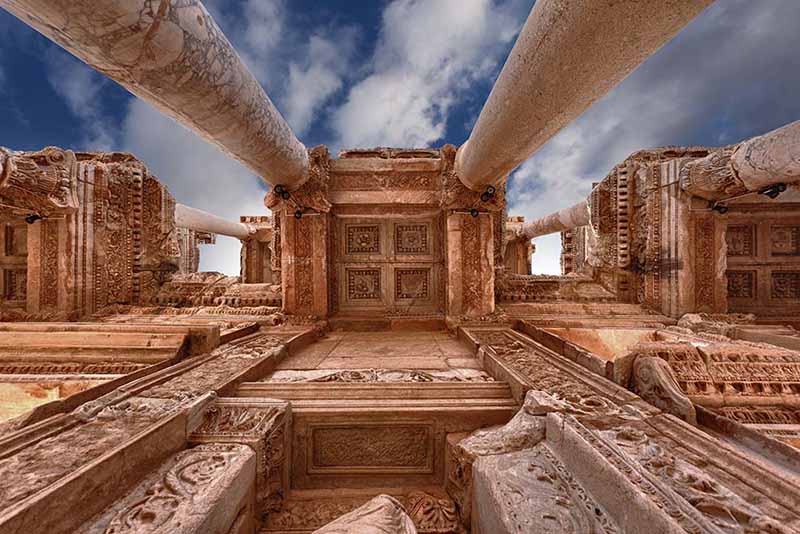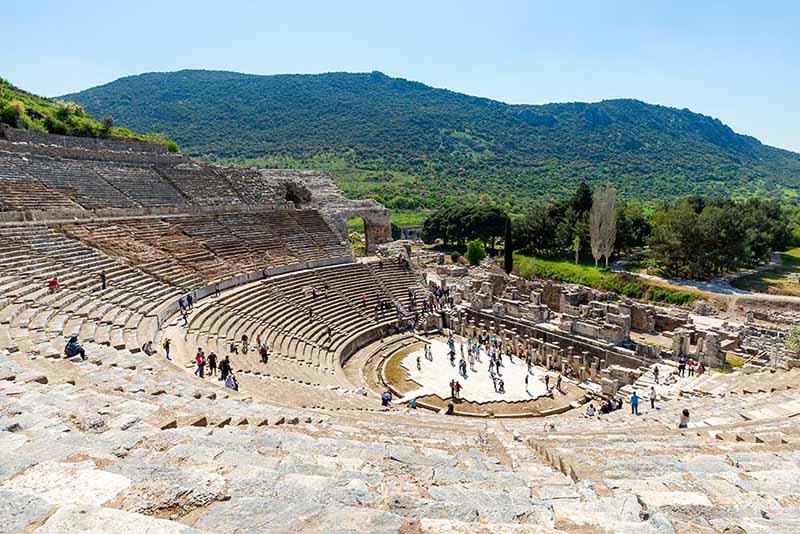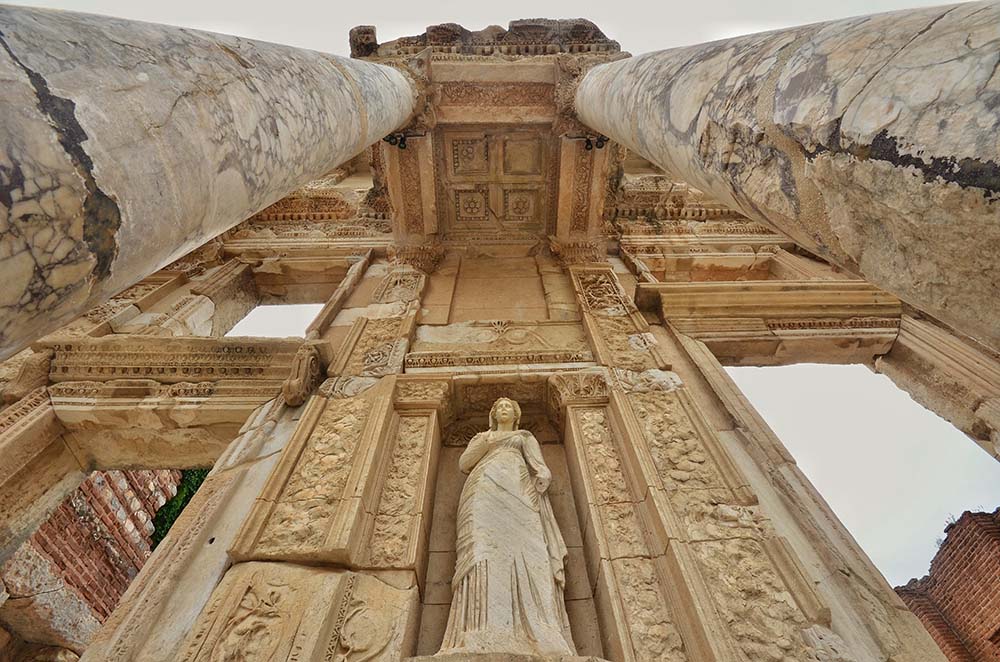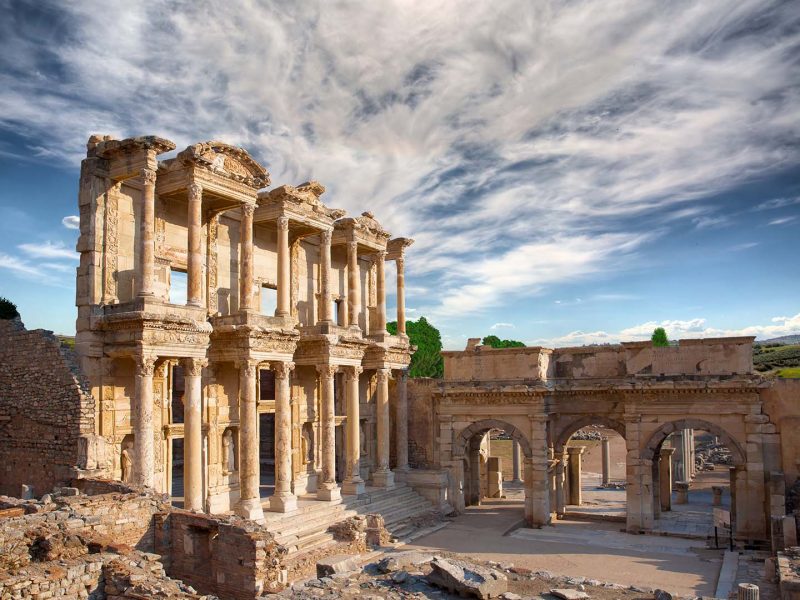The Ruins of Ephesus that have survived for hundreds of years will fascinate you with their peaceful, historical atmosphere. Ephesus is located in İzmir, in Turkey’s western region. Legend has it that İzmir was built by female warriors called “Amazons”. In the Hittite texts, it is referred as the capital city “Arpasa” of Arzawa. In the 12th and 11th centuries BC, the Greeks took over here and gave the area the name “Ephesus”. Later, due to the increase in sea migration, Ephesus was relocated to the Temple of Artemis. Ephesus, with its new location, became one of four major cities of the Romans and also an important port.
The Roman Empire had its heyday around 300 BC. In this period, the Ancient City of Ephesus’ historical structures were built and utilized, which can be visited today. However, the port had become unusable due to increase of alluvion over time. After that, it was relocated to near Saint John’s Basilica in Ayasuluk, which was built by the Byzantine Emperor Justinian. In the 1330s, the Turks captured this area. After the 16th century, it was named “Selçuk”. Ephesus, located in Selçuk in İzmir, has had a significant role in the field of science, civilization, and culture since its settlement around 6000 BC. Today, you can watch the most magnificent art events in the Great Theater Area, witness to the Christians‘ pilgrimage to the Virgin Mary’s house, and can breathe the Celsus Library’s mystery, when you visit Ephesus.
The Ruins of Ephesus are the home of many historical buildings. Vedius Gymnasium is one. It was built in the 2nd century BC by a wealthy man Publis Vedius Antonius. It is a magnificent building with its ceremonial hall, dressing rooms, baths, cultural, and sports training areas. There is a stadium located in the south of the building, used as a social gathering place where sports competitions were organized, gladiatorial comparisons were made, and Olympic games were played.

Library of Celsus, ruins of ancient city Ephesus, Turkey.
The Church of the Virgin Mary, located opposite the Byzantine baths, is an extremely important place not only in history but also for the Christian world. In 431, this was used as a consul meeting place. The building was converted into a basilica during the Roman period (2nd century) which was dedicated to the Virgin Mary. After the consul meeting in here, Jesus was accepted as the son of the Virgin Mary and God. In the 7th century, another unified church was built. This has been called “Double Churches.” The church has been recognized as a sacred center and as “the first church dedicated to the Virgin Mary” in particular.
The Great Theater, one of the magnificent structures of the Ruins of Ephesus, was designed in the Hellenistic period to have a capacity of approximately 24,000 people. It was rebuilt by Emperor Cladius during the Roman Empire. Construction was completed in the Trianus period of the Roman Empire, and the road that starts from the front of the theater to Ephesus Antique Port is known as Arkadian Harbor Street (Arkadiane Liman Caddesi). The road was designed for Emperor Arkadianus, and in the 5th century it was decorated with lighting. The road between the galleries has been used as a ceremonial hall.

Tourists on Amphitheater (Coliseum) in Ephesus Turkey. Ephesus contains the ancient largest collection of Roman ruins in the eastern Mediterranean.
The Commercial Agora, established during the Hellenistic period, has been used as a shopping center. The Celsus Library was built next to it for his father, Celsus, by Asian Consul Julius Aguila. It is considered the third largest library in the world. There is a transition from the back wall of the library to the tomb of Celsus. A Celsus sculpture is exhibited at the İstanbul Archeology Museum. The library reflects the most beautiful architectural works of the period. There is Marble Street between The Great Theater and the Celsus Library; this 400-meter road has laid marble. It is also accepted as a sacred path.
The Temple of Artemis is one of the Seven Wonders of the World. It is very important with its splendid structure representing the Hellenistic Period as well as being the first marble temple. The architectural details have disappeared over time; however, this is no obstacle to reminding us of its importance. As a result of archaeological studies, it is known that people lived here between 1500-300 BC. The temple, built in the name of the goddess Kybele, was built in the 8th century BC. It was devastated by fire in 356, then approximately 26 years later, the building was rebuilt. Today only a few columns still stand.

Celsus Library in Ephesus site, Selçuk, İzmir.
Seven Sleepers Cave is also considered as an important place in this area. Rumor has it that this cave was used as a religious center. It is thought that before Christianity was regarded as the official religion, seven young men who had escaped from the Pagans were sheltered here. Seven people fell asleep for 300 years, and woke up to see that Christianity was the official religion. After this miracle, the young men died and a huge monument was planted where they were buried. The historical remains of the Ruins of Ephesus are not limited to these: St. John’s Basilica, Ayasuluk Hill, the Virgin Mary’s House, Love House, Isa Bey Mosque and Bath, Aqueducts, Ephesus Archaeological Museum, and many other historical ruins are waiting to be visited in Ephesus.

